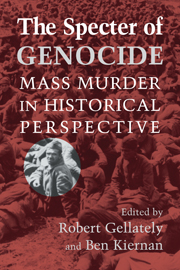Book contents
- Frontmatter
- Contents
- List of Contributors
- Acknowledgments
- INTRODUCTION
- PART I GENOCIDE AND MODERNITY
- PART II INDIGENOUS PEOPLES AND COLONIAL ISSUES
- 6 Genocides of Indigenous Peoples
- 7 Military Culture and the Production of “Final Solutions” in the Colonies
- 8 “Encirclement and Annihilation”
- PART III THE ERA OF THE TWO WORLD WARS
- PART IV GENOCIDE AND MASS MURDER SINCE 1945
- CONCLUSIONS
- Appendix: Convention on the Prevention and Punishment of the Crime of Genocide
- Index
8 - “Encirclement and Annihilation”
The Indonesian Occupation of East Timor
Published online by Cambridge University Press: 05 June 2012
- Frontmatter
- Contents
- List of Contributors
- Acknowledgments
- INTRODUCTION
- PART I GENOCIDE AND MODERNITY
- PART II INDIGENOUS PEOPLES AND COLONIAL ISSUES
- 6 Genocides of Indigenous Peoples
- 7 Military Culture and the Production of “Final Solutions” in the Colonies
- 8 “Encirclement and Annihilation”
- PART III THE ERA OF THE TWO WORLD WARS
- PART IV GENOCIDE AND MASS MURDER SINCE 1945
- CONCLUSIONS
- Appendix: Convention on the Prevention and Punishment of the Crime of Genocide
- Index
Summary
When the Indonesian armed forces launched their invasion of East Timor on December 7, 1975, there was a general consensus that it would be a short-lived affair. The poorly armed East Timorese independence movement would be no match for the Indonesian army. Internationally, Indonesia was seen by the governments of the industrialized states as a crucial regional ally, whereas East Timor had no significant international support and could easily be isolated economically, politically, and diplomatically by Indonesia.
Yet, almost a quarter of a century later, this “short-lived” intervention had not achieved its aim of integrating East Timor into the Indonesian Republic. Indeed, quite the opposite had occurred, with East Timor's people voting overwhelmingly for independence on August 30, 1999. In pursuit of Indonesia's aim, however, at least 200,000 East Timorese, almost one-third of its preinvasion population, had died. Thousands had been detained without trial, tortured, and disappeared. Most had been forcibly resettled, and lived under constant military surveillance. For most of this twenty-four-year period the leading governments of the industrialized world either ignored these events, or acquiesced in them, accepting Indonesian interpretations they knew were false.
In this chapter I focus on two issues. First, why were such extraordinary levels of brutality directed against the East Timorese population by its occupying army and administration? What led to the genocide? Second, why did the governments of the world acquiesce in these events?
- Type
- Chapter
- Information
- The Specter of GenocideMass Murder in Historical Perspective, pp. 163 - 186Publisher: Cambridge University PressPrint publication year: 2003
- 2
- Cited by



